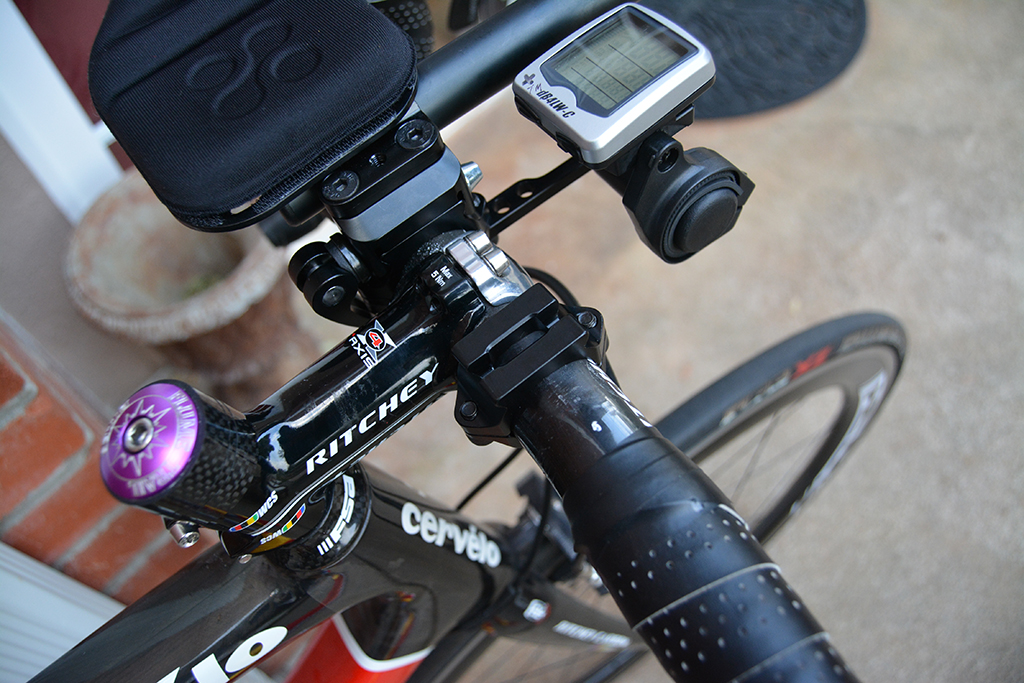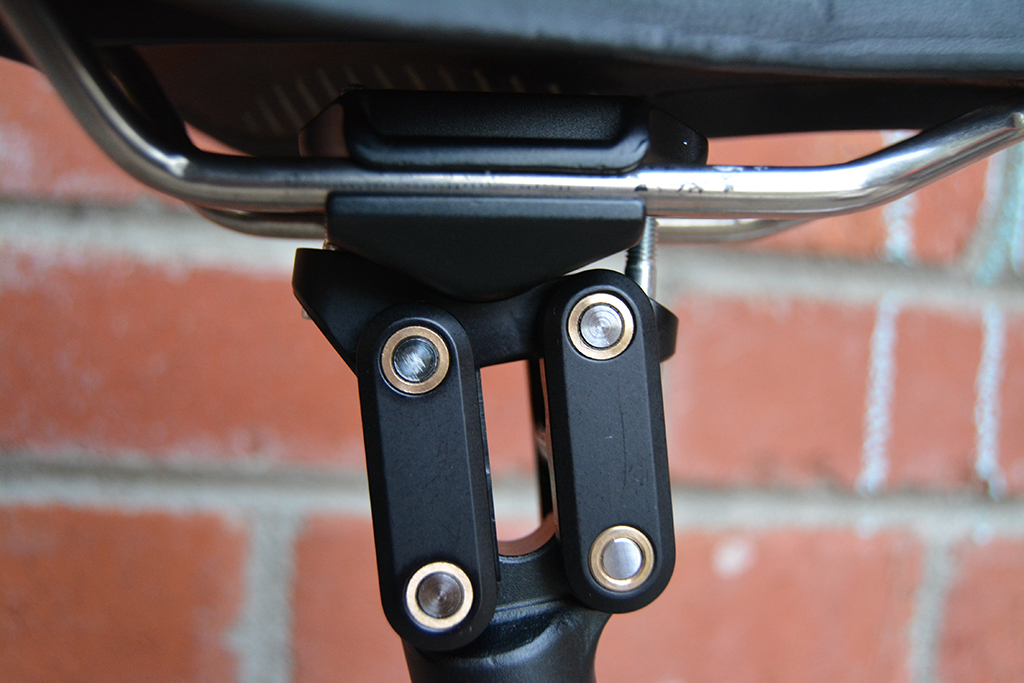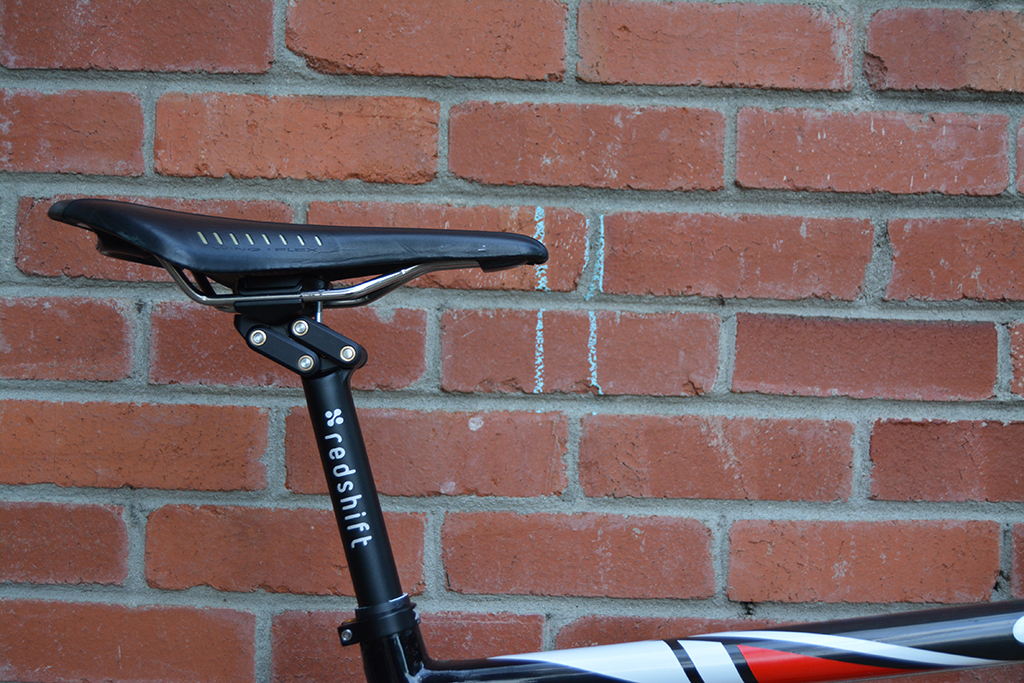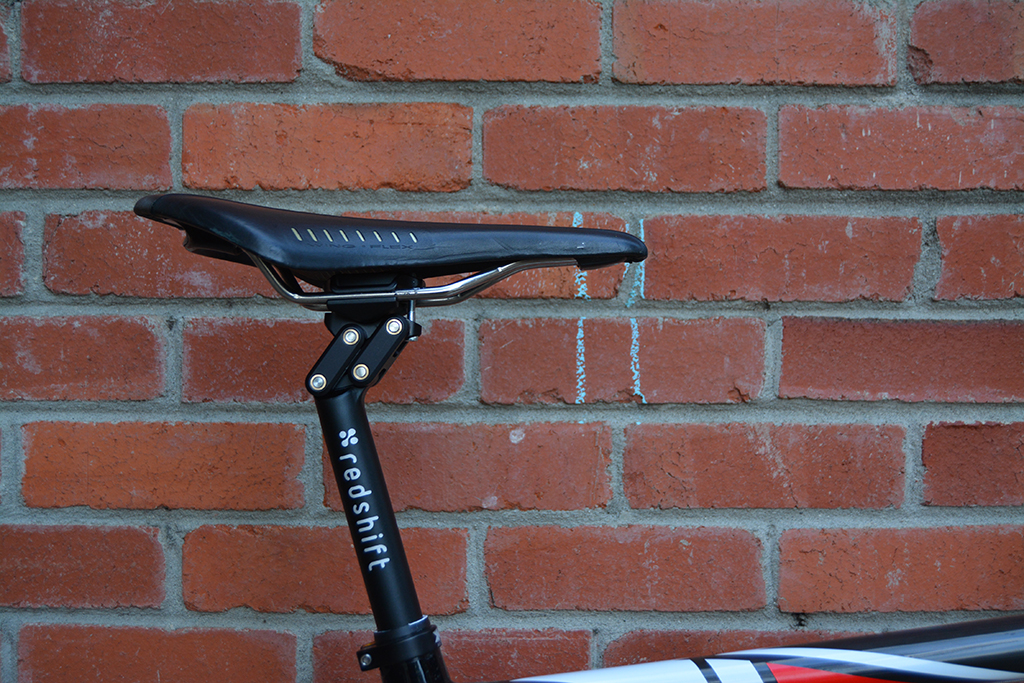Tested 1/25/15

Redshift Sports Switch Aero System
- Includes dual-position seatpost, quick-release clip-on aero bars & mounting kit, cyclometer mount and hydration kit.
- MSRP: $338.98 for the set; $299 for just the bars and seatpost. $169.00 for aerobars, $159.00 for seatpost alone.
- Weight. Seatpost: 400 grams, clip-on aero bars with fittings 630 grams; 9 grams lighter with S-Bend vs L-Bend alloy extensions. Carbon extensions are 60 grams lighter and $70 more expensive. Clip-on bar mounts are 83 grams.
- For more information and to buy, visit Redshift Sports.
Redshift was founded in 2013 by a bunch of mechanical engineers applying their passion to cycling components. They had some cool ideas and leveraged Kickstarter to fund the Switch Aero System. The Kickstarter response was impressive; they sought to raise $20,000 but ended up with nearly $50,000. Their products are designed to make it easy to convert a road bike to triathlon use with easy-to-remove aerobars and a dual-position seatpost that allows the rider to get into the more forward "tri position" easily.
First Impressions
I was initially more interested in the concept of quick-release aerobars than a reversible seatpost because aerobars are the biggest aerodynamic advantage you can add. The idea of quick release aerobars is even more appealing because I like the idea of reducing weight when riding "road style" without aerobars but like the flexibility of adding them easily. Plus, being able to easily remove aerobars is very convenient for putting a bike in the trunk of a car; aerobars can make the bike unweildly and awkward to fit.
With respect to the seatpost, in fact, on my Cervelo R3, I use a Ritchey Superlogic seatpost that I flop between rear-biased road riding and forward-biased triathlon riding so I didn't think the seatpost would be that that much of a revelation. Further, I assumed that the 400 gram seat post would be excessively heavy and I assumed that you'd have to reinstall the saddle for forward or backward-biased postion, so I immediatly discounted it.
Turns out my first impressions would change dramatically.
The seat post actually allows you to switch position on the fly, while riding. In fact, it gives you a full 50MM of fore/aft difference.This means that if your road bike seat tube angle is 73 degrees, you'll be able to achieve 77 degrees in the forward position (tri bikes typically offer 76 to 80 degrees). The Ritchey seatpost I use offers only 25MM of offset so it really doesn't get you in to the steep tri position. This is not a new idea; during the heyday of triathlon technology in the late '80's/early '90's, there was a product called the "Seat Shifter" popularized by pros like Mike Pigg which allowed triathletes to scoot the seat back and forth via a cable. So what exactly is the benefit of shifting the seat? On a road bike, with slacker seat angle, you can climb using a balance of your leg and glute muscles. The aero position forces more focus on the glutes and hamstring. The more forward positon also opens up your hip angle letting you ride more comfortably while bent over the aero bars. It also positions your upper body weight more evenly over the aerobars so you are using your skeletal system instead of your muscles to keep upright. Additonally, while going downhill, the more laid back road bike position biases weight toward the rear of the bike providing more control versus the front-heavy triathlon angle which can make for more tentative descending. The Redshift Dual-Position seatpost is a modernized execution of this concept of shifting the seat position and it does it extremely well. Incredibly, the articulated linkages maintain the exact same seat height (relative to the bottom bracket) whether forward or back. Very slick!
Installation
Installing the aerobars was relatively straightforward; simply attach the 83-gram bar mounts to the handlebar. Then, following the directions carefully, you sort of tug the quick release bar up on both ends while sliding the bar on to the bar mounts. Tighten the quick release and then push down. It was remarkable to me how rock-solid the bars felt with the quick release engaged; there was no play even though the quick releases were easy to clamp down. Moving to the seat post, it's pretty straight forward and easier than a lot of seat posts out there. You just need to fiddle with the seat angle and position via two allen-head screws. I also installed the optional cyclometer mount which mounted easily to the bar mounts using a longer and supplied bolt. (Note, I did not install the water bottle mount that fits in the aerobars though it was supplied and seemed very easy to do).
On the road
The aerobars were very comfortable though slightly wide because the bar mounts are outboard of the quick release mechanism. The aerobars felt good and there were no creaks nor slippage and the padding of the pads was very good.
The seatpost, however, was a revelation. It was awesome to easily shift from "road" to "tri" position by giving a tug or a push with your hand on the nose of the seat. It was welcome relief to be able to swap these positions. As a tentative descender myself, I particularly liked being able to push the saddle back on steep descents. In the aero position I felt as if I was on a proper tri-bike.
While not "on the road", riding the bike with the bars and the seatpost on a stationary trainer was fantastic. Because the seat is so easy to move backward and foward, it makes stationary training more interesting because you can easily switch from tri to road position to work different muscle groups. It also keeps your mind more engaged because of the different riding positions.
Who is it for?
If you are a weight weenie, these products aren't likely for you. At 630 grams, the aerobars are on the heavy side; comprable Profile bars are about 100 grams lighter (though, of course, can't be removed and reinstalled quickly). And comprably priced seat posts are also about 150 grams lighter, but, of course, they don't allow on-the-fly position changes.
But if you care less about weight and more about aerodynamics, convenience, and a reasonable price, they fit the bill.
If you are a roadie who dabbles in triathlon, these are absolutely for you. If you are a triathlete who is tentative while descending, these might also be for you. If you are an ultra distance cyclists, these might also be an interesting solution that allows you to change your position easily, recruiting different muscle groups.
Redshift provides a compelling, easy to install and easy to use solution for roadies who dabble in triathlon and new triathletes who don't want to spend a fortune on aero gear.
 Road position
Road position

Tri position

Cockpit 1

Cockpit 2

Cyclometer Mount

Forward position

Articulation

Rear position

Rear position

Forward position